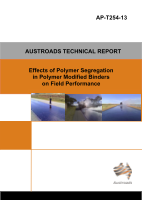Pavement

- Publication no: AP-T254-13
- ISBN: 978-1-925037-28-9
- Published: 28 October 2013
- PDF (free) Download
This study investigated whether the segregation propensity of a polymer modified binder (PMB) during hot storage affects its performance on the road.
The Australian PMB specification currently includes a segregation test which determines whether the polymer in a PMB will separate out under typical storage and transport conditions. In Europe, a more sensitive test, called the storage stability test, is used to determine whether polymer separation will occur during storage and transport of PMBs. A series of styrene-butadiene-styrene (SBS) based PMBs were manufactured in the laboratory and their performance properties in asphalt were assessed in order to determine whether the propensity of a PMB to segregate, as measured by these two tests, affected its performance on the road if the polymer in segregated PMBs could be redispersed by conventional mixing protocols prior to use. PMBs were produced at two different SBS polymer contents using samples of Class 170 (C170) bitumen which were obtained from three different sources.
The results obtained for the PMBs in wheel tracking and fatigue tests overall indicated that the resistance of the PMBs to permanent deformation and low temperature cracking in asphalt were not significantly affected by their propensities to segregate if they could be mixed prior to use. The fatigue lives of the PMBs in asphalt, however, appeared to be markedly affected by the type of C170 bitumen used to produce the PMB blends. If it is assumed that PMBs can be mixed in storage tanks and in the field using conventional mixing protocols in Australia, then the less sensitive segregation test appears sufficient to characterise the segregation propensities of Australian PMBs.
- 1. Introduction
- 2. EXPERIMENTAL DESIGN
- 2.1. Materials
- 2.2. PMB Sample Manufacture
- 2.3. PMB Sample Splitting
- 2.4. Binder Test Procedures
- 2.5. Asphalt Mix Design and Test Procedures
- 3. Results and Discussion
- 3.1. Binder Tests on Bitumens and the Polymer Combining Oil
- 3.2. PMB Blend Manufacture and Testing
- 3.2.1. Development of Low and High Polymer Content PMB Formulations
- 3.2.2. Low Polymer Content PMB Formulation Binder Test Results
- 3.2.3. High Polymer Content PMB Formulation Binder Test Results
- 3.2.4. Comparison of Storage Stability and Segregation Test Results
- 3.3. Wheel Tracking Tests
- 3.3.1. Wheel Tracking Tests on Low and High Polymer Content PMBs
- 3.3.2. Wheel Tracking Tests on C170 Bitumen Samples
- 3.3.3. Wheel Tracking Test Result Summary
- 3.4. Fatigue Tests
- 3.4.1. Fatigue Tests on Low and High Polymer Content PMBs
- 3.4.2. Fatigue Tests on C170 Bitumen Samples
- 3.4.3. Additional Fatigue Tests
- 3.5. General Discussion
- 4. CONCLUSIONS
- References
